quatrowins
44 posts
Latest Posts by quatrowins
Smooth magic!

141020
An axial piston contraption to complement the radial one. Rigging this was a gigantic pain…
Please please please, I’m begging people, start talking about indonesia occupied papua. Over the last 50 years Indonesia has killed over 500,000 native Papuans in their occupation of the west half of the island.
This is also a genocide that should be talked about. It needs to be addressed, but it’s ignored on the global stage.
Free Papua!


Inspiring Bedroom by @jellinadetmar
Get Inspired, visit www.myhouseidea.com

Renovated loft by @TienTung_Nguyen
Get Inspired, visit www.myhouseidea.com
Spectacular shots!!!















TOTAL SOLAR ECLIPSE l APRIL 2024
ALFREDO JUÁREZ | RAMI ASTRO | JOSHUA INTINI | KENDALL RUST | DERAN HALL | KUZCOKHANDA | TREVOR MAHLMANN | OTHINGSTODO | NASA | STEVEN RATNIK
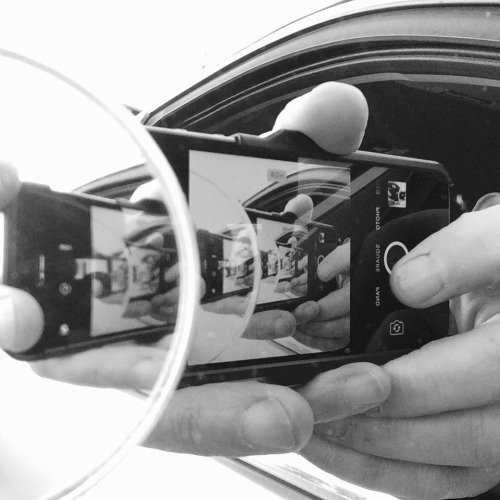
Recursion, 2017
Biertan is a destination.

Biertan, Romania (by Emilia Morariu)
Magic world!

Shibuya, Tokyo🏮🏮🏮
東京 渋谷

A clip from Anthony Bourdain’s Parts Unknown Singapore episode has resurfaced where he challenges the Singaporean hosts for exploiting domestic labour. The Vice article links to https://besthousekeeper.sg/domestic-helpers-in-singapore/ and the way they describe the different ethnic groups is frankly disgusting. See for example, these are from the website:




This is shameful.
How lovers call each other around the world
What makes lovers bloom in the most beautiful colors of their deepest inner feelings is a grave insult for 99% of all people around them.
Disclaimer: This is not a comprehensive list. I chose the weirdest/funniest terms.
Afrikaans: klein bokkie (little buck)
Arabic: بصري [basari] (my eyesight)
Catalan: colomí/colometa (pidgeon)
Dutch: dropje (little licorice), mopje (little joke)
English: “pumpkin”, “sweet pea”
Finnish: kulta (gold), muru (breadcrumb)
French: ma puce (my flea), mon chou (my cabbage)
German: Hase (bunny), Maus (mouse)
Indonesian: jantung hatiku (my heart and liver)
Irish: a leanbh (my child), mo chuisle (my pulse)
Italian: biscottino (little biscuit), microbino mio (my little microbe)
Japanese: 卵方の顔 [tamago hō no kao] (egg with eyes)
Korean: 우리강아지 [u-ri gang-a-ji] (my puppy)
Mandarin: 沉鱼落雁 (chényú luòyàn) ([beautiful enough to] make fish sink and birds alight), 心肝 [xīngān] (heart-liver)
Persian: باشد که یک موش شما را بخورد [bashed keh ak mewsh shema ra bekhewred] (May a mouse eat you)
Polish: misiu (little bear), okruszku (breadcrumb), rybko (little fish)
(Brazilian) Portuguese: chuchuzinho (little pumpkin)
Russian: лапочка [lapochka] (paw), рыбка [rybka] (little fish), голубчик/голубушка [golubchik/golubushka] (little pidgeon)
Spanish: cielo (sky), gordo/a (fat boy/girl)
Swedish: söt kanin (cute bunny)
Thai: ช้างน้อย [cĥāngn̂x/chang noi] (elephant)
Tibetan: སྙིང་སྡུག་ལགས། [nyingdu-la] (most honored poison of my heart)
Turkish: patlıcanım (my eggplant)

Taylor Swift is worth more than $300 million — see her bicoastal mansions, lavish vacations, and generous gifts to fans and friends
Hillary Hoffower August 19, 2018

Taylor Swift reportedly has a net worth of more than $300 million. Christopher Polk/Getty Images
Taylor Swift’s net worth is currently an estimated $320 million, according to Forbes, making her one of the world’s highest-paid celebrities.
Once Swift’s Reputation Stadium Tour ends this fall, her net worth could climb even higher.
Swift spends her fortune growing her $84 million real estate portfolio and donating to causes and charity.
Taylor Swift never fails to impress.
At 15 years old, she was the youngest songwriter to ever sign with Sony. She now has 10 Grammys on her shelf, several tours under her belt (including one that generated a staggering quarter of a billion dollars), an endless list of chart-topping songs and albums, and a beloved fan base who dub themselves “Swifties.”
Such success makes Swift one of the world’s highest-paid celebrities and one of the richest female singers. According to Forbes, she has an estimated net worth of $320 million — and that’s only expected to rise once her current six-month Reputation Stadium Tour wraps up later this year.
Swift has been strategic and generous with her money, investing in a sprawling $84 million real estate portfolio and often donating it to causes she supports and people in need.
Below, see how Swift earns and spends her fortune.
Taylor Swift currently has an estimated net worth of $320 million, which has grown due to her music, merchandise, and endorsements.

Kevork Djansezian/Getty Images
Source: Forbes
Ever the superstar, Swift’s endorsement deals and partnerships are with high-profile brands, including Keds, Diet Coke, CoverGirl, and Apple, which bring in a lot of income.

Charley Gallay/Getty Images
Source:Money
Swift has had a long-term partnership with Diet Coke since 2013, which has involved her chatting about her love for the drink in a “Bon Appetit” interview and holding the drink while on camera.

Anna Webber/Shutterstock
Source:Hollywood Reporter, Variety
Adele and Madonna, who have comparable fan bases to Swift, didn’t put as much effort into brand partnerships and touring as Swift did in 2016 — and only made half of her paycheck, at $80.5 million and $76.5 million respectively, according to Quartz.

Sascha Schuermann/Getty Images
Source:Quartz
In fact, aside from brand partnerships and endorsements, touring is Swift’s biggest money maker. Her 1989 tour grossed more than $250 million in 2015.

Graham Denholm/Shutterstock
Source: Forbes
She stands to earn even more than that during her current six-month Reputation Stadium Tour that began in May. Five shows in, Swift had already earned $54 million in sales — that’s $10.8 million per show.

Kevin Winter/Getty Images
Source: Forbes, Refinery29
But her tours don’t just bring in ticket sales. Billboard estimated that Swift sells $17 of merchandise per ticket at her shows.

Andreas Rentz/Getty Images
Source:Billboard
Swift was the world’s top-earning musician in June 2016, bringing home a record $170 million from 2015-2016, according to Forbes’ 2016 list. The same year, it was estimated that Swift makes $1 million a day.

Evan Agostini/AP Photos
Source:Forbes,Express
Swift had a more “quiet year” in 2017, according to Forbes, bringing in $44 million and ranking ninth on Forbes’ list of the world’s highest-paid celebrities.

Rich Polk/Getty Images
Source:Forbes
So far in 2018, not including touring revenues, Swift has earned an estimated $5 million in record sales, $2.4 million through streaming, and $2 million in publishing royalties, according to Billboard.

Chris Pizzello/Shutterstock
Source:Billboard
A few years ago, it was estimated Swift could become a billionaire by the time she turns 30. Here’s how she spends her fortune…

Carlo Allegri/Reuters
Source:Express
Swift is a real estate mogul, with a sprawling $84 million real estate portfolio that consists of eight properties in four different states, according to property values estimated by Trulia.

Jordan Strauss/AP Photos
Source: Business Insider, Trulia
In Nashville, she owns a 3,240-square-foot condo worth an estimated $3 million and a 5,600-square-foot Greek Revival estate worth an estimated $2.5 million. The latter is the cheapest property she owns.

Google Maps
Source: Business Insider, Trulia
In LA, Swift currently has a Beverly Hills home on the market for $2.85 million. She also owns a 10,982 square-foot Beverly Hills mansion worth nearly $30 million. She plans to turn it into a historic landmark.

From Trulia
Source: Business Insider, Trulia
Across the coast, Swift owns an estate with seaside views in Watch Hill, Rhode Island, valued at $6.65 million. With 12,000 square feet, it has plenty of room for parties with her squad.

Zillow
Source: Business Insider, Trulia
But that’s nothing compared to the estimated $40 million worth of property Swift owns in New York City on the same block in Tribeca. That includes a 8,309-square-foot large duplex penthouse and a four-story townhouse.

Taylor Swift bought this townhouse last year located at 153 Franklin St. It’s next to a complex where she now owns three units. Google Maps
Source: Business Insider, Trulia
Swift needs a way to travel among all these homes and she’s rumored to own two Dassault private jets. There’s no word on how much she paid for them, but depending on the model, they can be worth up to $58 million each.

Andrew H. Walker/Getty
Source: Forbes, GOBankingRates
Swift can also use her jet to head out of the country for vacation. She recently spent the Fourth of July in Turks and Caicos with her boyfriend Joe Alwyn and previously took a trip to an undisclosed tropical island with former boyfriend Calvin Harris.

Debbie Ann Powell/Shutterstock
Source:Elle, Travel + Leisure
At the end of her 1989 World Tour, Swift took her 125-person band and crew on a vacation in Australia.

Michael Loccisano/Getty Images
Source: Vanity Fair
But Swift has always been generous with her money, supporting causes and helping those in need. On her 24th birthday, she donated $100,000 to the Nashville Symphony.

Royce DeGrie/Getty Images
Source: People
She’s provided supported during natural disasters, donating $1 million to the victims of Louisiana floods and $500,000 to the Nashville flood relief, and raising $750,000 through a Speak Now Help Now benefit concert for victims of tornadoes in the southern US in 2011.

Caroline McCredie/Getty Images
Source: People
Swift is also supportive of education — she pledged $4 million to the Country Music Hall of Fame to fund the Taylor Swift Education Center and donated $50,000 to NYC public schools.

Larry Busacca/Getty Images
Source: People
She’s also donated to various GoFundMe campaigns, including $10,000 toward a service dog for an autistic boy and $50,000 to her backup dancer’s nephew, who was battling cancer.

Mark Humphrey/Getty Images
Source: People
And then there are the two famous checks she wrote for $1,989 — an ode to her best-selling album — sent to two fans to pay a student loan and to donate to a dance marathon benefit.

Larry Busacca/Getty Images
Source: People
She also helps out her friends, giving pal Kesha $250,000 to help with legal fees during her lawsuit against a music producer.

Kevin Winter/Getty Images
Source:People
But her thoughtfulness doesn’t end there. And when she once went out to dinner with pals Ed Sheeran and Austin Mahone in Philadelphia, she reportedly left a generous $500 tip.

Christopher Polk/Getty Images
Source:E News
Swift often spends money dining out with her squad and boyfriends, especially when in New York City, where she’s dined at The Fat Radish, The Spotted Pig, Sarabeth’s, and L'Asso, where she had a glass of wine and a gluten-free pizza.

KGC-146/STAR MAX/IPx/Getty Images
Source:People
But Swift also saves money dining in. She reportedly loves to cook and bake and has hosted several elaborate dinner parties with her squad.

Jason Merritt/Getty Images
Source:Glamour, InStyle
Swift also has a fur squad. She has two Scottish Fold cats, Meredith Grey and Olivia Benson. The breed costs around $1,000 to $1,500. Her cats even have their own line of merchandise at her store.

Evan Agostini/Shutterstock
Source:Refinery 29, Cat Breeds List
When she’s not chilling at home, Swift is usually rocking designer duds during appearances or some serious street style in New York City, often mixing high-end and fast fashion. She’s been spotted wearing Saint Laurent sneakers, A Christian Louboutin backpack for $1,237, and an Elie Saab gown.

Michael Loccisano/Getty Images
Source:Who What Wear
But Swift’s also sported more affordable pieces, such as $60 Steve Madden sandals and Gen Z-obsession Brandy Melville. She seems to have an affinity for Madewell, whose clothes range around $72 for a pair of shorts or $62 for a denim crop top.

KGC-146/STAR MAX/IPx/AP Photos
Source:Who What Wear, Who What Wear, People
But for all the generous giving and strategic investments Swift has made with her money, she has reportedly used it in one rumored indulgence: $40 million to insure her famous legs.

Andreas Rentz /Getty Images
Source:New York Post
Business Insider

Pedi women, South Africa, by Medu

Phinda Rock Lodge South Africa
© andBeyondPhinda

Bari vecchia, Italia by @icharous
To be understood maybe first to be transparent.
“There’s nothing more intimate in life than simply being understood.”
— Brad Meltzer
House in Ecuador is well… in good hiding.

Hidden Stone House Ecuador by A1 Arquitectura. Photo by Bicubik @bicubik.photo.
Get Inspired, visit www.myhouseidea.com
House in Yokohama is cool.

House in Yokohama is a minimal residence located in Kanagawa, Japan, designed by Airhouse. The plan is to seek a bright and open space while ensuring privacy on a site that is surrounded by three directions and has a north-facing road, and has strict building coverage ratio, floor area ratio, and height restrictions. Like the neighboring land, the site was one step higher than the front road and was filled with embankment.
Smart technique!
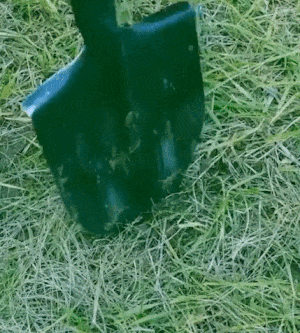
Good idea


I approve @anyone.
everyone talks about how tumblr should make an @everyone feature, but I have another proposal: an @anyone feature. this tags a few users at random and there’s no way of predicting who it will be. this will also solve nothing and make everything worse
I want a house by each of these lakes…
Here it is folks:
My definitive ranking of my least favorite bodies of water! These are ranked from least to most scary (1/10 is okay, 10/10 gives me nightmares). I’m sorry this post is long, I have a lot of thoughts and feelings about this.
The Great Blue Hole, Belize

I’ve been here! I have snorkeled over this thing! It is terrifying! The water around the hole is so shallow you can’t even swim over the coral without bumping it, and then there’s a little slope down, and then it just fucking drops off into the abyss! When you’re over the hole the water temperature drops like 10 degrees and it’s midnight blue even when you’re right by the surface. Anyway. The Great Blue Hole is a massive underwater cave, and its roughly 410 feet deep. Overall, it’s a relatively safe area to swim. It’s a popular tourist attraction and recreational divers can even go down and explore some of the caves. People do die at the Blue Hole, but it is generally from a lack of diving experience rather than anything sinister going on down in the depths. My rating for this one is 1/10 because I’ve been here and although it’s kinda freaky it’s really not that bad.
Lake Baikal, Russia
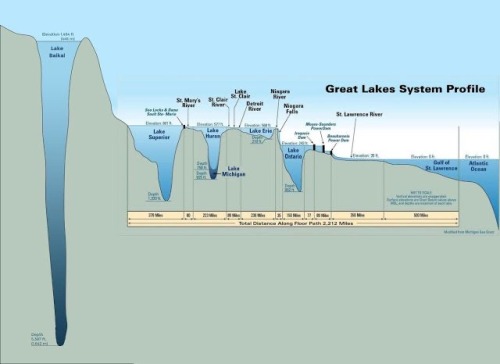
When I want to give myself a scare I look at the depth diagram of this lake. It’s so deep because it’s not a regular lake, it’s a Rift Valley, A massive crack in the earth’s crust where the continental plates are pulling apart. It’s over 5,000 feet deep and contains one-fifth of all freshwater on Earth. Luckily, its not any more deadly than a normal lake. It just happens to be very, very, freakishly deep. My rating for this lake is a 2/10 because I really hate looking at the depth charts but just looking at the lake itself isn’t that scary.
Jacob’s Well, Texas
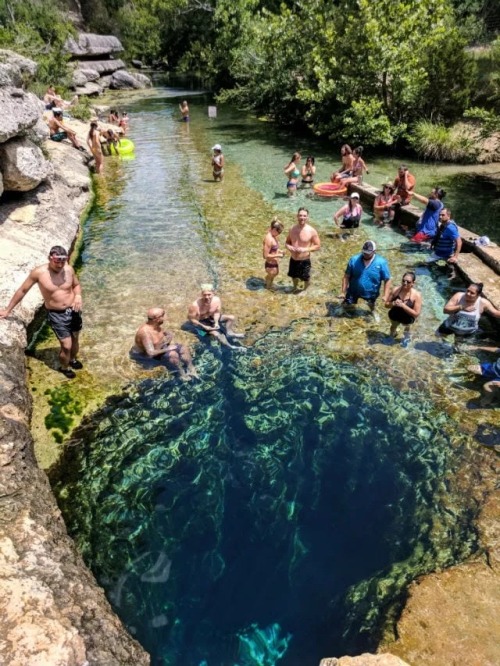
This “well” is actually the opening to an underwater cave system. It’s roughly 120 feet deep, surrounded by very shallow water. This area is safe to swim in, but diving into the well can be deadly. The cave system below has false exits and narrow passages, resulting in multiple divers getting trapped and dying. My rating is a 3/10, because although I hate seeing that drop into the abyss it’s a pretty safe place to swim as long as you don’t go down into the cave (which I sure as shit won’t).
The Devil’s Kettle, Minnesota
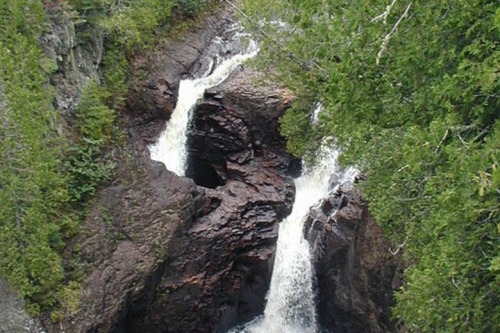
This is an area in the Brule River where half the river just disappears. It literally falls into a hole and is never seen again. Scientists have dropped in dye, ping pong balls, and other things to try and figure out where it goes, and the things they drop in never resurface. Rating is 4/10 because Sometimes I worry I’m going to fall into it.
Flathead Lake, Montana
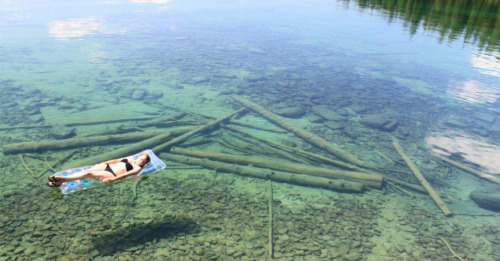
Everyone has probably seen this picture accompanied by a description about how this lake is actually hundreds of feet deep but just looks shallow because the water is so clear. If that were the case, this would definitely rank higher, but that claim is mostly bull. Look at the shadow of the raft. If it were hundreds of feet deep, the shadow would look like a tiny speck. Flathead lake does get very deep, but the spot the picture was taken in is fairly shallow. You can’t see the bottom in the deep parts. However, having freakishly clear water means you can see exactly where the sandy bottom drops off into blackness, so this still ranks a 5/10.
The Lower Congo River, multiple countries
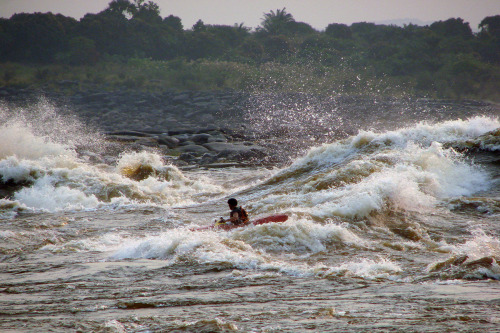
Most of the Congo is a pretty normal, if large, River. In the lower section of it, however, lurks a disturbing surprise: massive underwater canyons that plunge down to 720 feet. The fish that live down there resemble cave fish, having no color, no eyes, and special sensory organs to find their way in the dark. These canyons are so sheer that they create massive rapids, wild currents and vortexes that can very easily kill you if you fall in. A solid 6/10, would not go there.
Little Crater Lake, Oregon
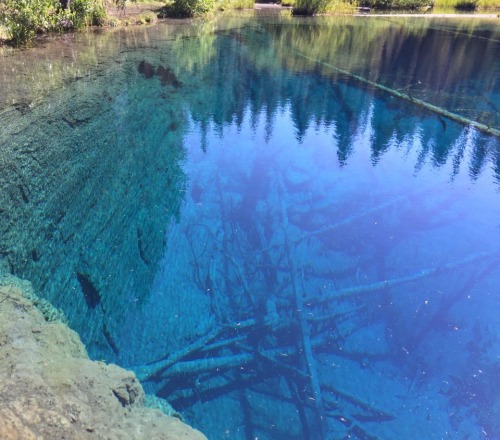
On first glance this lake doesn’t look too scary. It ranks this high because I really don’t like the sheer drop off and how clear it is (because it shows you exactly how deep it goes). This lake is about 100 feet across and 45 feet deep, and I strongly feel that this is too deep for such a small lake. Also, the water is freezing, and if you fall into the lake your muscles will seize up and you’ll sink and drown. I don’t like that either. 7/10.
Grand Turk 7,000 ft drop off
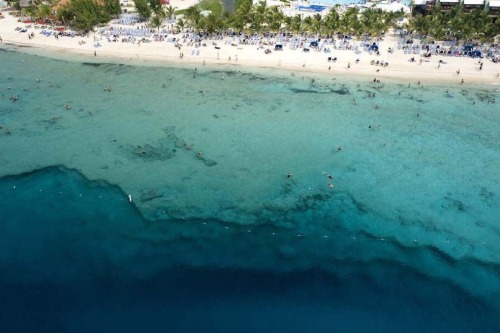
No. 8/10. I hate it.
Gulf of Corryvreckan, Scotland
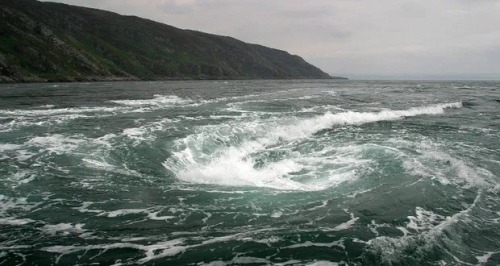
Due to a quirk in the sea floor, there is a permanent whirlpool here. This isn’t one of those things that looks scary but actually won’t hurt you, either. It absolutely will suck you down if you get too close. Scientists threw a mannequin with a depth gauge into it and when it was recovered the gauge showed it went down to over 600 feet. If you fall into this whirlpool you will die. 9/10 because this seems like something that should only be in movies.
The Bolton Strid, England
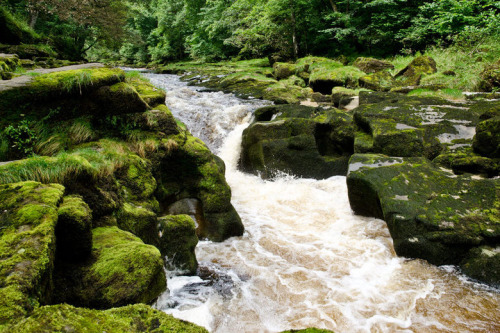
This looks like an adorable little creek in the English countryside but it’s not. Its really not. Statistically speaking, this is the most deadly body of water in the world. It has a 100% mortality rate. There is no recorded case of anyone falling into this river and coming out alive. This is because, a little ways upstream, this isn’t a cute little creek. It’s the River Wharfe, a river approximately 30 feet wide. This river is forced through a tiny crack in the earth, essentially turning it on its side. Now, instead of being 30 feet wide and 6 feet deep, it’s 6 feet wide and 30 feet deep (estimated, because no one actually knows how deep the Strid is). The currents are deadly fast. The banks are extremely undercut and the river has created caves, tunnels and holes for things (like bodies) to get trapped in. The innocent appearance of the Strid makes this place a death trap, because people assume it’s only knee-deep and step in to never be seen again. I hate this river. I have nightmares about it. I will never go to England just because I don’t want to be in the same country as this people-swallowing stream. 10/10, I live in constant fear of this place.
Honorable mention: The Quarry, Pennsylvania
I don’t know if that’s it’s actual name. This lake gets an honorable mention not because it’s particularly deep or dangerous, but it’s where I almost drowned during a scuba diving accident.
About the Pantheon in Rome, Italy…
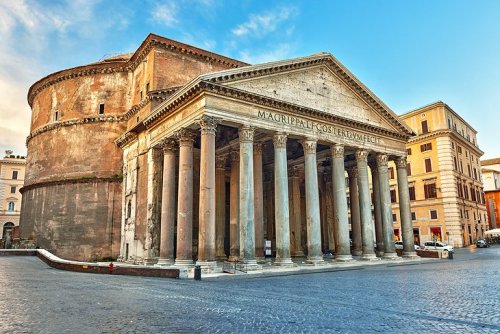
The Pantheon in Rome
The Pantheon in Rome, now a church, was built as a temple to all the gods. It has been a shrine for architects since the Renaissance. It is also a worthy tribute to the skills of the ancient Roman masons and engineers who built it and the incredible alchemy of their concrete mix.
If there Was a competition to find the most durable and beautiful concrete structure ever built, the Pantheon in Rome would most surely win the prize. It also stands as a monument to the genius of Roman concrete.
Commissioned by Hadrian (who was emperor 117-138 CE) as a temple to all the gods, the Pantheon replaced Agrippa’s earlier temple following a fire. It is still the most visited site in Italy, having weathered centuries of tourists, floods, wars and earthquakes.
Its huge concrete dome – 43.4m in diameter and 21.75m high – was unrivalled in size until the building of Florence Cathedral in the 1400s, and is still the largest ever made with unsupported concrete.
“The mastery of building something so daring and having the structure resist essentially without any structural support for more than 19 centuries is simply extraordinary,” says Renato Perucchio, professor of mechanical engineering and director of the Archaeology, Technology, and Historical Structures Programme at the University of Rochester in the US.
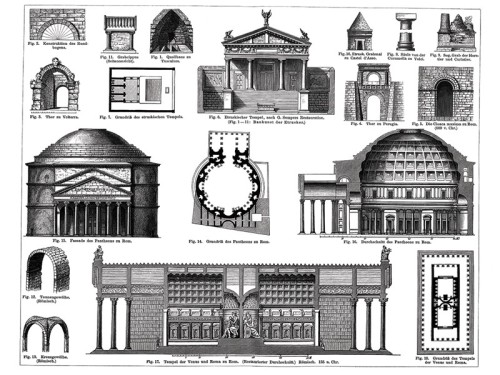
So how did the Romans do it, what were the secrets of their concrete recipe and what lessons can architects and civil engineers learn from its construction today?
As every builder knows, foundations are everything. One of the most overlooked aspects of the Patheon’s remarkable construction lies below its famous dome. Although Rome is not on one of Italy’s major seismic zones, it has known earthquakes. Many historians believe seismic activity caused damage to the Colosseum. Moreover, until some of the River Tiber’s tributaries were buried in the late 19th century, it was also subject to major flooding.
The foundations of the Pantheon were made of concrete, originally 4.7m deep and 7.3m thick. During construction, however, they cracked due to the marshy, clay land below. “For this reason, a second reinforcement ring was built, projecting three metres beyond the original perimeter,” according to the Archeoroma website. Thick buttress walls were also built to the south of the building anchored to the Basilica of Neptune next door. “This had the effect of stabilising the structure by counterbalancing the forces and weights at either end of it,” Archeoroma writes.
Romans did not invent concrete. It had already been around for hundreds of years before the Pantheon was built.
Curiously that accolade probably goes to the Nabatean Bedouin tribes of the land that is today southern Syria and northern Jordan, who were using it to create hidden underground water cisterns around 700BC.
The basic concrete recipe the Romans followed can be found in the Roman architect Vitruvius’s book ‘De Architectura’, published 100 years before the building of the Pantheon. He described how to make concrete out of lime and pozzolana sand, a type of volcanic ash found near Naples, all mixed with stone mass.
Different aggregates were used to give the concrete diverse densities. Travertine limestone gave the Pantheon’s foundations a density of 2,200kg per cubic metre, while lighter rock was chosen for the dome.
Pozzolans, made of siliceous and aluminous materials, possess little or no cementitious value, but when mixed with water, react chemically with calcium hydroxide at ordinary temperature to form cementitious compounds.
It was the chemistry of this material that formed the basis of the durability of the dome, enabling it to survive two millennia without the steel tension rods used today.

Indeed, the Romans understood that the bigger the structure, the stronger it was, because the simplest way to keep concrete in compression is to put heavy stuff on top of it, like more concrete.
It is a trick still used today. Many large concrete dams are either gravity or arch structures that rely on their own weight and geometry to withstand water.
However, the circular structure of the dome meant that before the ancient engineers could start making its concrete ceiling, they needed to figure out how to direct the weight away from the centre. If they didn’t, and removed the wooden structure holding it in place, the 3,000 tonnes of concrete used to make the dome would have pushed outwards and the whole edifice would have collapsed under its own weight.
Even the kind of scaffolding framework used to support such a framework is still under discussion. “Think of the design of the scaffolding that holds a structure of that weight,” says Perucchio. “They [the ancient Romans] had a high mastery in using timber framing in a way that no other earlier cultures had developed.”
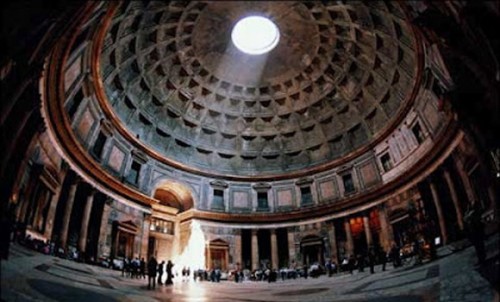
Today when we build in concrete, we introduce a steel tension rod which picks up half of the stresses in the concrete. The Romans used their ancient concrete recipe, and an abundance of highly skilled artisan labour, who tamped the stiff mixture into moulds and walls, rather than pouring it as is done today.
To build the dome, the Roman builders constructed a solid base, a wall six metres thick in the shape of a rotunda, to act as the foundation for the ceiling. They then used the vertical walls on either side to buttress the dome itself.
As the ceiling rose towards its apex, the master craftsmen mixed increasingly lighter aggregate materials into the concrete.
This principle of using different weights of aggregate goes from the heavy travertine used in the base right up to the top of the dome.
“It doesn’t look like it from the inside but on the outside it’s a very thick dome, but relatively light,” says Norbert Delatte, head of the School of Civil and Environmental Engineering at Oklahoma State University.
In some parts, the ancient builders mixed in small clay vases, called amphorae, to control the weight.
The aggregate of the concrete used to make the upper dome region consists of alternating layers of light tuff, found in abundance north of Rome, and pumice stone, the material we use today to file off rough skin. The concrete substance at the top of the dome had a density of just 1,350kg per cubic metre.
To make the ceiling even lighter, masons moulded recessed concrete waffle-like panel bricks called coffers; five layers of these bricks formed the interior ceiling. They pounded the concrete into the moulds using some kind of tamper, most likely made of wood or iron.
This meant that aesthetically, they had allowed an area of the dome to be decorated while simultaneously reducing the amount of concrete necessary for the dome itself.
At the top, the Pantheon’s crowning glory is an open oculus, 7.8m in diameter, which allowed light to shine in, adding to the sense of wonderment the building still incites today. But most importantly, it meant the apex of the dome was made of the lightest material of all, air.

Today, engineers all over the world are looking at the chemical properties of Roman concrete to see if it can be reproduced today to make buildings that last longer. Although the basic ingredients were set out by Vetruvius, modern measuring technologies are making it easier to ascertain the exact chemical properties from just small samples of material.
Yet the clever use of engineering and the unique Roman concrete material is not the only reason this enduring temple to all the gods is still there to inspire awe today. History also played a role in its staying power. The event that probably most ensured its long destiny happened in 609 AD, nearly 400 years after it was built.
The Emperor Phocas, the Byzantine emperor in the east, gave the Pantheon to the Catholic Church in Rome. The Vatican has used it as a place of worship ever since, while its formidable structure also still serves a shrine for architects and engineers the world over.
By Hilary Clarke.
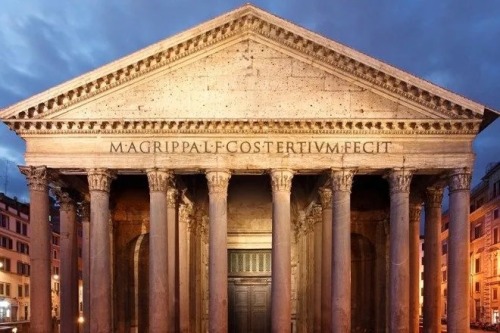
Yeah… let’s start with the smell of coffee
“If today gets difficult, remember the smell of coffee, the way sunlight bounces off a window, the sound of your favorite person’s laugh, the feeling when a song you love comes on, the color of the sky at dusk, and that we are here to take care of each other.”
— Chaplain Bob Keller, The Chaplain’s Corner (Washington46.org, May 7, 2020)
People want to come in, but they’re running out of spaces… in the hallways.
You decide.
https://apple.news/AEfjzV4cGRIyKfCrHjhGkrA

Life… imitating art.






























Nice photography!

踊りの前の静けさ
2012年、築地本願寺。
本格的に盆踊りが始まる前の櫓。和太鼓がある時を待つ。
